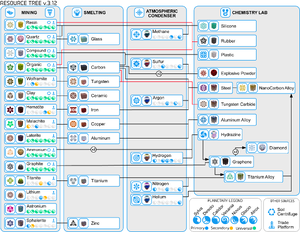Resources
Resources are items that make up nearly every item in Astroneer. Resources can be obtained by extraction, crafting, trading at the Trade Platform, finding them on Discoveries, and rewarded from missions. They are mainly used as ingredients to craft the various Items in the game. Apart from that, some resources may be converted into Power using generators, with all of them being able to be converted into Bytes using the Research Chamber, or sometimes used in a limited time event.
There are four main types of resources: natural, atmospheric, refined, and composite resources. Natural resources vary in rarity, with some occurring on every planet and others only appearing on a couple of planets. Likewise, atmospheric resources, or gases, are available on most planets, except for Desolo, with two types of gases available on Sylva, Calidor and Novus, four on Atrox, three on Vesania and only a single atmospheric resource on Glacio . Most natural and atmospheric resources are used to create refined and composite resources at a Smelting Furnace or Chemistry Lab.
Some resources, such as ![]() Scrap,
Scrap, ![]() EXO Chips, biofuels,
EXO Chips, biofuels, ![]() Oxygen, and
Oxygen, and ![]() Power do not fit into any of these categories.
Power do not fit into any of these categories.
Resources
Natural Resources
The following resources are found naturally on all planets:
The following natural resources are found on specific planets:
| Resource | Refines To | ||||||
|---|---|---|---|---|---|---|---|
| ✔️ | ✔️ | ➖ | ➖ | ➖ | ➖ | ||
| ➖ | ✔️ | ✔️ | ➖ | ➖ | ➖ | ||
| ✔️ | ➖ | ✔️ | ➖ | ➖ | ➖ | ||
| ➖ | ➖ | ➖ | ✔️ | ✔️ | ➖ | ||
| ➖ | ➖ | ➖ | ➖ | ✔️ | ✔️ | ||
| ➖ | ➖ | ➖ | ✔️ | ➖ | ✔️ |
Refined Resources
The items listed in the table below are refined using the Smelting Furnace.
| Refined Resource | Raw Resource |
|---|---|
Atmospheric Resources
This table lists the part per unit (PPU) the player may get on a planet of each atmospheric resource using an Atmospheric Condenser. A higher PPU will result in a shorter gathering time.
| Resource | ||||||
|---|---|---|---|---|---|---|
| 75 | 50 | 100 | 25 | × | × | |
| × | × | 50 | × | 100 | × | |
| × | × | × | 75 | × | 100 | |
| 100 | × | 75 | × | × | 50 | |
| × | 100 | × | × | × | 75 | |
| × | × | × | × | × | 25 |
Composite Resources
The items in the table below are composite resources created in the Chemistry Lab, with some requiring an Atmospheric Resource.
| Composite Resource | Resource 1 | Resource 2 | Gas |
|---|---|---|---|
| n/a | |||
| n/a | |||
| n/a | |||
| n/a | |||
| n/a | |||
| n/a | |||
Other Resources
Sources
Extraction
The most common way of obtaining resource nuggets is extracting them, either directly from resource deposits, from the atmosphere, or from Soil in a Soil Centrifuge. These resources can be used to be crafted into refined or composite resources using a Smelting Furnace or a Chemistry Lab, respectively.
Using the Terrain Tool or Drills, players may extract resources from naturally formed deposits found scattered throughout the various planets. The deposits will break and will provide the player with nuggets of the resources. By using an Auto Extractor to extract from deposits, the player may obtain fifteen times the number of nuggets than extracting manually provide. For example, if a deposit would give 10 nuggets, using an Auto Extractor would provide at least 150 nuggets of a resource.
![]() Organic and
Organic and ![]() Soil are unique in gathering, as they both don't have their own deposits. Organic is gathered by digging up various types of plant cover found on the planets or by using a Tapper on certain Flora, while Soil is collected from the terrain. To collect soil, a Small Canister is required while digging to collect the soil for use, which will fill gradually as the player digs.
Soil are unique in gathering, as they both don't have their own deposits. Organic is gathered by digging up various types of plant cover found on the planets or by using a Tapper on certain Flora, while Soil is collected from the terrain. To collect soil, a Small Canister is required while digging to collect the soil for use, which will fill gradually as the player digs.
Atmospheric resources are extracted from the atmosphere by using an Atmospheric Condenser. It will create a nugget of gas inside of a canister that the player does not need to provide. Once the nugget is full, if available, it will move to an open slot or into a Medium Gas Canister, and a new nugget will start being produced.
Players may use Soil inside of Small Canisters in a Soil Centrifuge to gather some basic natural resources, with some resources requiring more soil per nugget. The following resources may be extracted from the soil: ![]() Organic,
Organic, ![]() Compound,
Compound,![]() Resin,
Resin, ![]() Clay,
Clay, ![]() Quartz,
Quartz,![]() Ammonium, and
Ammonium, and ![]() Graphite.
Graphite.
Trading
By utilizing Shredders, players may use ![]() Scrap in a Trade Platform to trade for natural resources. Resources cost scrap to trade for, with more advanced resources costing more per nugget. With a decent setup using a couple Large Rovers, an RTG, and an Extra Large Shredder, a player could clean up a planet and obtain an abundant supply of resources.
Scrap in a Trade Platform to trade for natural resources. Resources cost scrap to trade for, with more advanced resources costing more per nugget. With a decent setup using a couple Large Rovers, an RTG, and an Extra Large Shredder, a player could clean up a planet and obtain an abundant supply of resources.
Alternatively, the player can obtain Scrap by extracting Astronium and trading it for Solid-Fuel Jump Jets, which have the best ratio among the other shreddables with 3 Scrap/Astronium.
Discoveries
Various resources may be found on various discoveries found around the planets, such as space debris, lost backpacks, and supply drops. Consumables, different Items, as well as valuable salvageable parts may also be found for the player to utilize.
Uses
Smelting
Several natural resources can be smelted in a Smelting Furnace, which refines the resource into a refined resource, e.g. ![]() Laterite into
Laterite into ![]() Aluminum. Most naturally occurring metallic ores and
Aluminum. Most naturally occurring metallic ores and ![]() Clay must be be refined in order to be of any value other than for research.
Clay must be be refined in order to be of any value other than for research. ![]() Organic and
Organic and ![]() Quartz may also be refined, but they also have uses in their unrefined form.
Quartz may also be refined, but they also have uses in their unrefined form. ![]() Soil,
Soil, ![]() Compound,
Compound, ![]() Resin,
Resin, ![]() Ammonium,
Ammonium, ![]() Graphite,
Graphite, ![]() Lithium, and
Lithium, and ![]() Astronium cannot be refined.
Astronium cannot be refined.
Composite Resources
Using the Chemistry Lab, natural, refined, and atmospheric resources may be combined into a composite resource. Composite resources are used in mid to late game progression, allowing the player to craft more advance items, such as Automation items or RTGs.
Crafting
With the exception of ![]() Soil and unrefined metallic ores, all other natural, refined, or composite resources can be used to craft items using Printers. Players will always be printing items, from the start of the game to the end.
Soil and unrefined metallic ores, all other natural, refined, or composite resources can be used to craft items using Printers. Players will always be printing items, from the start of the game to the end.
Storage
Resource nuggets are Tier 1 items and thus can be attached to any attachment slot. Nuggets may also be stored inside of the appropriate canister.
Research
Natural and Refined resources, as well as Scrap, can be researched in a Research Chamber for bytes. They can provide an early stream of bytes before the player finds research items that provide more bytes per second.
Other uses
![]() Organic and
Organic and ![]() Carbon may be converted into Power using generators, destroying the nugget in the process.
Carbon may be converted into Power using generators, destroying the nugget in the process.
![]() Hydrazine may be used as fuel for Hydrazine Thrusters, VTOL, or Hydrazine Jet Packs.
Hydrazine may be used as fuel for Hydrazine Thrusters, VTOL, or Hydrazine Jet Packs.
Trivia
- Atrox only contains universal and some atmospheric resources and has no primary or secondary resource.
- Desolo does not have any gas to collect with an Atmospheric Condenser.
- Oxygen nuggets, Power nuggets, Resin, and Compound used to be found in spires, which were removed in 0.4.10221.0. Oxygen nuggets and Power nuggets were also found in small deposits across cave walls, before they were removed entirely in version 0.10.1.0.
- All solid resource nuggets, whether raw, refined, or composite, consists of 50 bits of a resource.
- Originally Ice was intended to be smelted into water, which would then create Hydrogen, this idea was scrapped to make hydrogen available inside the atmospheric condenser. Both water and ice were never released in any form.
Media
| ||||||||||||||||||||
| |||||||||||||||||




